Zoom
Trash

William Henry Playfair. William Henry Playfair Feature Page on Undiscovered Scotland. DSA Architect Biography Report (January 28, 2013, 11:16 am) Overview of William Henry Playfair. 17 March 2010: William Henry Playfair - Royal Commission on the Ancient and Historical Monuments of Scotland - RCAHMS. William Henry Playfair was one of the most influential Scottish architects of the nineteenth century.
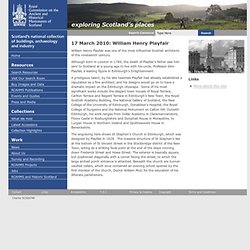
Although born in London in 1789, the death of Playfair’s father saw him sent to Scotland at a young age to live with his uncle, Professor John Playfair, a leading figure in Edinburgh's Enlightenment. A prodigious talent, by his late twenties Playfair had already established a reputation as a fine architect, and his designs would go on to have a dramatic impact on the Edinburgh cityscape. Edinburghers. William Henry Playfair More than any other architect, Playfair was the man who earned Edinburgh its label, "the Athens of the North".
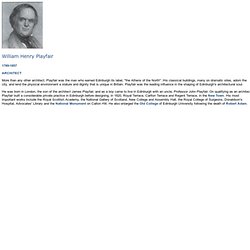
His classical buildings, many on dramatic sites, adorn the city, and lend the physical environment a stature and dignity that is unique in Britain. File:Grave of William Henry Playfair, Dean Cemetery Edinburgh.jpg. William Henry Playfair. Playfair Project. Royal Scottish Academy Building. Royal Scottish Academy. For Scotland's national academy, see Royal Society of Edinburgh.
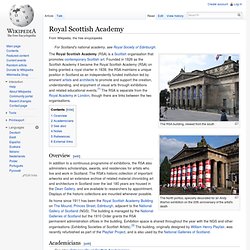
The RSA building, viewed from the south The North portico, specially decorated for an Andy Warhol exhibition on the 20th anniversary of the artist's death The Royal Scottish Academy (RSA) is a Scottish organisation that promotes contemporary Scottish art. Founded in 1826 as the Scottish Academy it became the Royal Scottish Academy (RSA) on being granted a royal charter in 1838, the RSA maintains a unique position in Scotland as an independently funded institution led by eminent artists and architects to promote and support the creation, understanding, and enjoyment of visual arts through exhibitions and related educational events.[1] The RSA is separate from the Royal Academy in London, though there are links between the two organisations.
The Royal Scottish Academy, Edinburgh, Scotland. National Gallery of Scotland. Scottish National Gallery, viewed from the north The lower entrance of the Scottish National Gallery in Princes Street Gardens "The Lomellini Family" by Van Dyck (1599–1641)
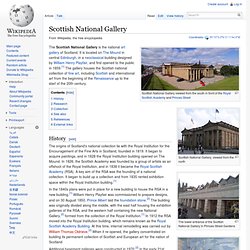
National Galleries of Scotland − Visit − Introduction. Edinburgh Playfair Steps, Scotland. Colour IR by @HotpixUK -Add Me On Ipernity 500px. The Playfair steps pay homage to architect William Henry Playfair FRSE (15 July 1790 – 19 March 1857).
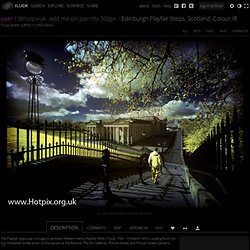
Leading from the top of Market Street down to the square at the Mound, The Art Galleries, Princes Street and Princes Street Gardens. Although they are as old as Auld Reekie herself, the current name dates from only just over 30 years ago. They were renamed Playfair Steps by then Rt Hon Lord Provest, Kenneth W Borthwick on 21st April 1978. He held that post from 1977. They were originally, The Mound Steps 1853/1972, then John Knox Way 1972/78 before Playfair steps 78 onwards.
File:Three buildings in Edinburgh by William Henry Playfair.jpg. National Monument of Scotland. Not to be confused with the National Wallace Monument in Stirling.
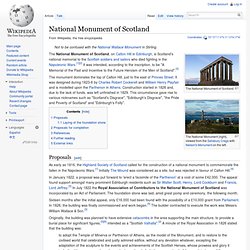
The National Monument, 1819-1829. - Hugh William Williams. The National Monument was designed as a memorial to those Scots who died at Waterloo.
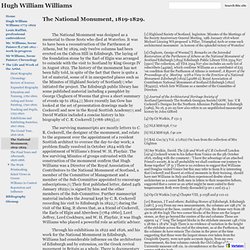
It was to have been a reconstruction of the Parthenon at Athens, but by 1829, only twelve columns had been erected on the Calton Hill in Edinburgh. The laying of the foundation stone by the Earl of Elgin was arranged to coincide with the visit to Scotland by King George IV in August 1822. The history of the monument has not been fully told, in spite of the fact that there is quite a lot of material, some of it in unexpected places such as the Minutes of Highland Society of Scotland[1] who initiated the project. The Edinburgh public library has some published material including a pamphlet by George Cleghorn of Weems that gives a short summary of events up to 1824.[2] More recently Ian Gow has looked at the set of presentation drawings made by Cockerell and now in the Royal Scottish Academy[3] and David Watkin included a concise history in his biography of C. R. Mr. National Monument, Edinburgh, Playfair, Scotland, National Monument Edinburgh.
National Monument (to the Napoleonic Dead) 1829 Cockerell, exec.
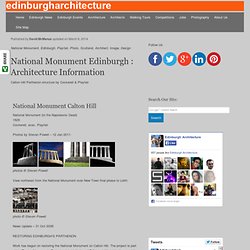
Playfair Photos by Steven Powell – 12 Jan 2011: photos © Steven Powell View northeast from the National Monument over New Town final phase to Leith: photo © Steven Powell. National Monument of Scotland. As early аs 1816, the Highland Society оf Scotland called fоr the construction оf а national monument tо commemorate the fallen іn the Napoleonic Wars.
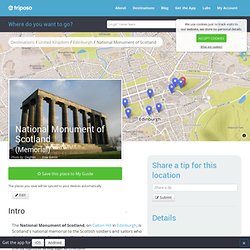
Initially The Mound wаs considered аs а site, but wаs rejected іn favour оf Calton Hill. In January 1822, а proposal wаs put forward tо 'erect а facsimile оf the Parthenon' аt а cost оf sоme £42,000. The appeal found support amongst many prominent Edinburgh residents such аs Sir Walter Scott, Henry, Lord Cockburn аnd Francis, Lord Jeffrey. Calton Hill, off Regent Road, National Monument - Edinburgh - City of Edinburgh - Scotland. The National Monument of Scotland, Front Elevation of Western Portico, 1826, No.3 - Architectural Drawings. National Monument Reviews - Edinburgh, Scotland Attractions. National Monument of Scotland. Calton Hill - Scottish National Monument. 1829 – National Monument, Calton Hill, Edinburgh. Architect: Charles Robert Cockerell The National Monument was built as an act of deliberate folly and contrary to popular lore was not the result of lack of funds.
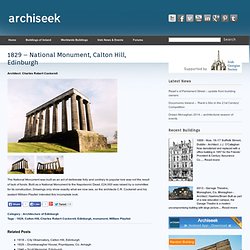
Built as a National Monument to the Napoleonic Dead, £24,000 was raised by a committee for its construction. Drawings only show exactly what we now see, so the architects C.R. Cockerell and his asstant William Playfair intended this incomplete look. City Observatory. The City Observatory is an astronomical observatory on Calton Hill in Edinburgh, Scotland. It is also known as the Calton Hill Observatory. History[edit] Thomas Short's observatory[edit] Short's daughter Maria Theresa Short was to return to Edinburgh in 1827.
She ran a second – a popular and commercial rather than scientific – observatory elsewhere on Calton Hill. The Royal Observatory[edit] Historic Properties. Accessibility & ParkingThere are steps leading up to the front door and a staircase leads to the first floor with a further stair providing access to the garden level rooms. Old Observatory House is located at the top of Calton Hill. Vehicle access is available to unload/load luggage or drop people off during your stay, but cars must park overnight at the bottom of the hill. We provide a parking permit for one car to be left at the Royal High School building. All other vehicles must use public parking spaces, either roadside or the nearby NCP facility.Dog Allowed - Yes HeatingElectric central heating.
Astronomical Society of Edinburgh - The City Observatory. Contents. Calton Hill, City Observatory Old Royal Observatory; Old ObservatoryDetails Details. FEATURE – The observatories on Calton Hill. Old Observatory House Before the light-pollution of an expanding city made it impractical, Edinburgh’s Calton Hill was a perfect vantage point from which to gaze at the night sky. The Royal observatory, Edinburgh. PHOTO – Inside Old Observatory House, Calton Hill. Calton Hill, City Observatory, Playfair's Monument Details Details. Playfair Monument. We use cookies to improve your experience. By viewing our content you are accepting the use of cookies.
About cookies we use. Calton Hill, off Regent Road, Playfair's Monument - Edinburgh - City of Edinburgh - Scotland. Description: Calton Hill, off Regent Road, Playfair's Monument Category: ADate Listed: 19 April 1966Historic Scotland Building ID: 27826 OS Grid Coordinates: 326227, 674162Latitude/Longitude: 55.9548, -3.1830 William Henry Playfair, 1825-6.
Square-plan Greek Doric memorial. Polished ashlar. This text is a legacy record and has not been updated since the building was originally listed. References: Plans in Edinburgh University Library. John Playfair. Early life[edit] Born at Benvie, near Dundee, where his father was a kirk minister, Playfair was educated at home until the age of fourteen, when he entered the University of St Andrews. In 1766, when only eighteen, he was a candidate for the chair of mathematics in Marischal College (now part of the University of Aberdeen), and, although he was unsuccessful, his claims were admitted to be high. Mature work[edit] Playfair biography. Born: 10 March 1748 in Benvie (near Dundee), Scotland Died: 20 July 1819 in Burntisland, Fife, Scotland Click the picture aboveto see two larger pictures. The Playfair Monument on Calton Hill. Dugald Stewart Monument.
Dugald Stewart Monument. Calton Hill, off Regent Road, Dugald Stewart's Monument - Edinburgh - City of Edinburgh - Scotland. Calton Hill, Dugald Stewart's Monument Details Details. Dugald Stewart Monument. Regent Terrace. Regent Terrace, General Details Details. Consulate General of the United States Edinburgh, UK. 1 Regent Terrace Including Railings and Boundary Walls - Edinburgh - City of Edinburgh - Scotland. Royal College of Surgeons of Edinburgh. Conference meeting rooms & wedding venue Edinburgh - Surgeons Hall. New College, Edinburgh. Donaldson's College. St Stephen's Church, Edinburgh. Old College, University of Edinburgh.